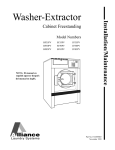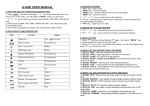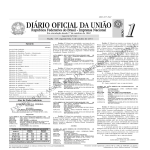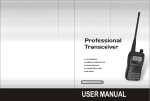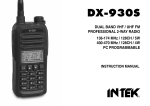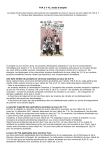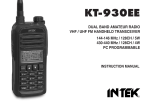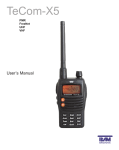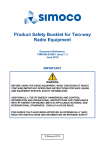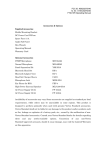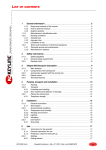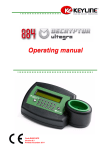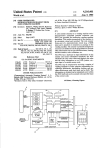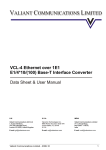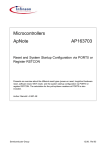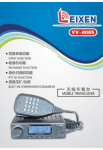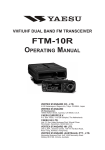Download VZ-88 Owner`s Manual
Transcript
Operating Manual Product Safety and RF Energy Exposure Booklet for Portable Two-Way Radios ........................................... 3 RF Energy Exposure Awareness, Control Information and Operational Instructions for Occupational Use .................................................... 3 Federal Communication Commission (FCC) Regulations ............................................................. 4 RF Exposure Compliance and Control Guidelines and Operating Instructions ...................................... 5 Approved Accessories ............................................ 6 Electromagnetic Interference/Compatibility............. 6 Use of Communication Devices While Driving ........ 7 Operational Cautions .............................................. 8 Intrinsically Safe Radio Information ........................ 9 Accessories Installation ............................................. 11 Ni-MH/Li-ion battery Installation ............................ 11 Detach Ni-MH/Li-ion Battery ................................. 11 Antenna Installation .............................................. 12 Detach Antenna .................................................... 12 Belt Clip Installation .............................................. 13 Power Adaptor and Commonly Used Charger ...... 13 Battery and Charger .................................................. 14 Battery Life Time ................................................... 14 Battery Charging with Radio ................................. 14 Battery Charging Only ........................................... 15 Charger LED Indicators ........................................ 15 Charging Time ....................................................... 15 Cleaning and Maintenance ....................................... 15 General Description .................................................. 16 Familiar with VZ-88 Radio ..................................... 16 LCD Icons ............................................................. 17 Digit Keypad .......................................................... 18 Basic Operations ................................................... 18 Power On/Off ............................................................ 18 Volume Adjustment .................................................. 18 Frequency Display Mode (VFO) ................................ 18 Channel Save ............................................................ 18 Channel Display Mode (MR) ..................................... 19 FM Frequency Display Mode (FM VFO) .................... 19 FM Channel Save ...................................................... 19 FM Channel Display Mode (MR) ............................... 19 Short Cut Key ............................................................ 19 Menu Selec on Mode(MENU) ............................ 19 Keypad Lock or Unlock ............................................. 19 Communica on Requirement .................................. 19 RX and Signal Strength Indica on............................. 20 Calling and Monitor .................................................. 20 Hands Free / VOX ..................................................... 20 LCD Backlit ................................................................ 20 Ini aliza on .............................................................. 20 LED Indicator ........................................................ 21 Tones..................................................................... 21 Short Cut Keys .......................................................... 22 Menu Setting ............................................................. 25 Menu List............................................................... 25 Menu Operation .................................................... 26 Menu Functions or Settings .................................. 26 ALIAS - Channel Alias ................................................ 26 APO - Auto Power Off ............................................... 26 Channel BANK ........................................................... 26 CONTENTS CONTENTS 1 CONTENTS 2 BATSAV – Ba ery Saver ............................................. 27 BCLO - Busy Channel Lock Out .................................. 27 BEEP – Key Tone Beep ............................................... 27 BW - Band Width ...................................................... 27 DW - Dual Watch ....................................................... 27 LIGHT Op ons ........................................................... 27 LOCK Mode Se ng ................................................... 27 OPNMSG – Opening Display Message....................... 28 PSWD – Password Se ng ......................................... 28 ROGER Se ng ........................................................... 28 TOT (TX Time- out - mer) Se ng ............................ 28 TXSTOP Se ng .......................................................... 28 VOX Se ng ............................................................... 28 OFFSET – VFO frequency offset ................................. 29 STEP – VFO frequency step ....................................... 29 CPS ........................................................................... 29 Channel Information setting .................................. 29 VFO Information setting ........................................ 29 Function parameter setting ................................... 30 DTMF setting ........................................................ 30 FM function setting................................................ 30 Scan List ............................................................... 30 Programmable side button .................................... 30 Monitor ..................................................................... 30 Scan On/Off ............................................................... 30 Nuisance Delete ........................................................ 30 High/Low Power ........................................................ 30 Talk-around/Repeater ............................................... 31 Back Light On/Off ...................................................... 31 Clone Function .......................................................... 31 The Steps of Clone Operation: .............................. 31 PL/DPL Frequency/Code Table .................................32 Standard PL (CTCSS) Frequency (Hz) Table: .......32 Standard DPL (CDCSS) Code Table: ....................33 The information provided in this document supersedes the general safety information contained in user guides published prior to February 2002. BEFORE USING THIS RADIO, READ THIS BOOKLET WHICH CONTAINS IMPORTANT OPERATING INSTRUCTIONS Caution FOR SAFE USAGE, RF ENERGY AWARENESS, CONTROL INFORMATION AND OPERATIONAL INSTRUCTIONS, FOR COMPLIANCE WITH RF ENERGY EXPOSURE LIMITS IN APPLICABLE NATIONAL AND INTERNATIONAL STANDARDS. ALSO READ THE OPERATIONAL INSTRUCTIONS FOR SAFE USAGE. FOR RADIOS THAT HAVE BEEN APPROVED AS INTRINSICALLY SAFE, READ THE INSTRUCTIONS AND INFORMATION ON INTRISINIC SAFETY ON PAGE 3-9 OF THIS BOOKLET. ! RF Energy Exposure Awareness, Control Information and Operational Instructions for Occupational Use NOTICE: This radio is intended for use in occupational/controlled conditions where users have full knowledge of their exposure and can exercise control over their exposure to meet the occupational limits in FCC and International standards. This radio device is NOT authorized for general population consumer use. Product Safety Product Safety and RF Energy Exposure Booklet for Portable Two-Way Radios This two-way radio uses electromagnetic energy in the radio frequency (RF) spectrum to provide communications between two or more users over a distance. It uses radio frequency (RF) energy or radio waves to send and receive calls. RF energy is one form of electromagnetic energy. Other forms include, but are not limited to, sunlight and x-rays. RF energy, however, should not be confused with these other forms of electromagnetic energy, which when used improperly, can cause biological damage. Very high levels of x-rays, for example, can damage tissues and genetic material. Experts in science, engineering, medicine, health, and industry work with organizations to develop standards for safe exposure to RF energy. These standards provide recommended levels of RF exposure for both workers and the general public. These recommended RF exposure levels include substantial margins of protection. 3 Product Safety All Vertex Standard two-way radios are designed, manufactured, and tested to ensure they meet government- established RF exposure levels. In addition, manufacturers also recommend specific operating instructions to users of two-way radios. These instructions are important because they inform users about RF energy exposure and provide simple procedures on how to control it. Please refer to the following websites for more information on what RF energy exposure is and how to control your exposure to assure compliance with established RF exposure limits: http://www.fcc.gov/oet/rfsafety/rf-faqs.html http://www.osha.gov/SLTC/radiofrequencyradiation/i ndex.html Federal Communication Commission (FCC) Regulations 4 The FCC rules require manufacturers to comply with the FCC RF energy exposure limits for portable two-way radios before they can be marketed in the U.S. When two-way radios are used as a consequence of employment, the FCC requires users to be fully aware of and able to control their exposure to meet occupational requirements. Exposure awareness can be facilitated by the use of a product label directing users to specific user awareness information. Your Vertex Standard two-way radio has a RF Exposure Product Label. Also, your Vertex Standard user manual or separate safety booklet includes information and operating instructions required to control your RF exposure and to satisfy compliance requirements. Compliance with RF Exposure Standards Your Vertex Standard two-way radio is designed and tested to comply with a number of national and International standards and guidelines (listed below) for human exposure to radio frequency electromagnetic energy. This radio complies with the IEEE (FCC) and ICNIRP exposure limits for occupational/controlled RF exposure environments at operating duty factors of up to 50% talk–50% listen and is authorized by the FCC for occupational use only. In terms of measuring RF energy for compliance with these exposure guidelines, your radio generates measurable RF energy only while it is transmitting (during talking), not when it is receiving (listening) or in standby mode. NOTE: The approved batteries, supplied with this radio, are rated for a 5–5–90 duty factor (5% talk–5% listen–90% standby) even though this radio complies with FCC occupational exposure limits and may operate at duty factors of up to 50% talk Your Vertex Standard two-way radio complies with the following RF energy exposure standards and guidelines: United States Federal Communications Commission, Code of Federal Regulations; 47CFR American National Standards Institute (ANSI) / Institute of Electrical and Electronic Engineers (IEEE) C95.1-1992 Do not remove the RF Exposure Label from the device. User awareness instructions should accompany device when transferred to other users. Do not use this device if the operational requirements described herein are not met. Institute of Electrical and Electronic Engineers (IEEE) 95.11999 Edition International Commission on Non-Ionizing Radiation Protection (ICNIRP) 1998 Ministry of Health (Canada) Safety Code 6. Limits of Human Exposure to Radiofrequency Electromagnetic Fields in the Frequency Range from 3 kHz to 300 GHz, 1999 Australian Communications Authority Radio communications (Electromagnetic Radiation– Human Exposure) Standard, 2003 ANATEL ANNEX to Resolution No. 303 of July 2, 2002 "Regulation of limitation of exposure to electrical, magnetic and electromagnetic fields in the radio frequency range between 9 KHz and 300 GHz" and "Attachment to resolution # 303 from July 2, 2002" RF Exposure Compliance and Control Guidelines and Operating Instructions To control your exposure and ensure compliance with the occupational/controlled environment exposure limits, always adhere to the following procedures. Guidelines: Operating Instructions Transmit no more than the rated duty factor of 50% of the time. To transmit (talk), push the Push-To-Talk (PTT) button. To receive calls, release the PTT button. Transmitting 50% of the time, or less, is important because this radio generates measurable RF energy exposure when transmitting (in terms of measuring for standards compliance). Hold the radio in a vertical position in front of the face with the microphone (and other parts of the radio including the antenna) at least 2.5 centimeters (one inch) away from the nose or lips. Antenna should be kept away from the eye. Keeping the radio at a proper distance is important since RF exposures decrease with increasing distance from the antenna. When worn on the body, always place the radio in a Vertex Standard approved clip, The use of nonVertex Standard approved accessories may result in exposure levels, which exceed the FCC occupational/controlled environment RF exposure Product Safety part 2 sub-part J 5 Product Safety limits. Approved Accessories Use only Vertex Standard approved supplied or replacement antennas, battery chargers and batteries. Use of Non Vertex Standard approved antennas, battery chargers and batteries may exceed the FCC (IEEE) and ICNIRP RF exposure guidelines. Electromagnetic Interference/Compatibility Pacemakers The Advanced Medical Technology Association (AdvaMed) recommends that a minimum separation of 6 inches (15 centimeters) be maintained between a handheld wireless radio and a pacemaker. These recommendations are consistent with those of the U.S. Food and Drug Administration. NOTE: Nearly every electronic device is susceptible to electromagnetic interference (EMI) if inadequately shielded, designed, or otherwise configured for electromagnetic compatibility. Persons with pacemakers should: ALWAYS keep the radio more than 6 inches (15 centimeters)from their pacemaker when the radio is turned ON. Facilities Not carry the radio in the breast pocket. To avoid electromagnetic interference and/or compatibility conflicts, turn off your radio in any facility where posted notices instruct you to do so. Hospitals or health care facilities may be using equipment that is sensitive to external RF energy. Use the ear opposite the pacemaker to minimize the potential for interference. Turn the radio OFF immediately if there is any reason to suspect that interference is taking place. Aircraft Hearing Aids When instructed to do so, turn off your radio when on board an aircraft. Any use of a radio must be in accordance with applicable regulations per airline crew instructions. 6 Medical Devices Some digital wireless radios may interfere with some hearing aids. In the event of such interference, you may want to consult your hearing aid manufacturer to discuss alternatives. Other Medical Devices Use of Communication Devices While Driving Always check the laws and regulations on the use of radios in the areas where you drive. Give full attention to driving and to the road. Use hands-free operation, if available. Pull off the road and park before making or answering a call, if driving conditions or regulations so require. ! WARNING For Vehicle with Air Bags Refer to vehicle manufacturer's manual prior to installation of electronic equipment to avoid interference with air bag wiring. Do not place a portable radio in the area over an air bag or in the air bag deployment area. Air bags inflate with great force. If a portable radio is placed in the air bag deployment area and the air bag inflates, the radio may be propelled with great force and cause serious injury to occupants of the vehicle. Product Safety If you use any other personal medical device, consult the manufacturer of your device to determine if it is adequately shielded from RF energy. Your physician may be able to assist you in obtaining this information. Operational Warnings 7 Product Safety ! WARNING Potentially Explosive Atmospheres (Explosive atmospheres refer to hazard classified locations that may contain hazardous gas, vapors, or dusts.) Turn off your radio prior to entering any area with a potentially explosive atmosphere unless it is a portable radio type especially qualified for use in such areas as Intrinsically Safe (for example, Factory Mutual, CSA, UL, or CENELEC). Do not remove, install, or charge batteries in such areas. Sparks in a potentially explosive atmosphere can cause an explosion or fire resulting in bodily injury or even death. The areas with potentially explosive atmospheres referred to above include fueling areas such as below decks on boats, fuel or chemical transfer or storage facilities, and areas where the air contains chemicals or particles such as grain, dust or metal powders. Areas with potentially explosive atmospheres are often, but not always, posted. 8 Blasting Caps and Blasting Areas ! WARNING To avoid possible interference with blasting operations, turn off your radio when you are near electrical blasting caps, in a blasting area, or in areas posted: “Turn off two-way radio.” Obey all signs and instructions. Operational Cautions ! Antennas Do not use any portable radio that has a Caution damaged antenna. If a damaged antenna comes into contact with your skin, a minor burn can result. ! Batteries All batteries can cause property damage Caution and/or bodily injury, such as burns, if a conductive material such as jewelry, keys, or beaded chains touches exposed terminals. The conductive material may complete an electrical circuit (short circuit) and become quite hot. Exercise care in handling any charged battery, particularly when placing it inside a pocket, purse, or other container with metal objects. The Intrinsically safe approval unit refers to a product that has been approved as intrinsically safe by an approval agency (for example FM Approvals, CSA, UL, or Cenelec) and certifies that a particular product meets the Agency's applicable intrinsic safety standards for specific types of hazardous classified locations. A portable radio that has been approved for intrinsic safety will have Approval label attached to the radio to identify the unit as being approved for specified hazardous atmospheres. This label specifies the hazardous Class/Division/ Group along with the part number of the battery that must be used. The Intrinsically Safe Approval Label will be located on the portable radio unit. Operational Cautions for Intrinsic Safe Equipment ! Caution Do not operate radio communications equipment in a hazardous atmosphere unless it is a type especially qualified (for example, FM, UL, CSA, or CENELEC approved). An explosion or fire may result. Do not operate a radio unit that has been approved as intrinsically safe product in a hazardous atmosphere if it has been physically damaged (for example, cracked housing). An explosion or fire may result. Do not replace or charge batteries in a hazardous atmosphere. Contact sparking may occur while installing or removing batteries and cause an explosion or fire. Warnings for Radios Approved as Intrinsically Safe Product Safety Intrinsically Safe Radio Information Radios must ship from the Vertex Standard manufacturing facility with the hazardous atmosphere capability and the intrinsic safety approval labeling (FM, UL, CSA, CENELEC). Radios will not be upgraded to this capability and labeled once they have been shipped to the field. A modification changes the unit's hardware from its original design configuration. Modifications can only be made by the original product manufacturer. ! Do not replace or change accessories in a hazardous atmosphere. Contact sparking may occur while installing or removing accessories and cause an explosion or fire. Do not replace or change accessories in a hazardous atmosphere. Contact sparking may occur while installing or removing accessories and cause an explosion or fire. WARNING 9 Product Safety 10 ! WARNING Turn the radio off before removing or installing a battery or accessory. Do Not Substitute Options or Accessories Do not disassemble an intrinsically safe product in any way that exposes the internal circuits of the unit. Failure to use an intrinsically safe approved battery or Approved accessories specifically approved for the radio unit may result in the dangerously unsafe condition of an unapproved radio combination being used in a hazardous location. The Vertex Standard communications equipment certified as intrinsically safe by the approving agency (FM, UL, CSA, CENELEC), is tested as a complete system which consists of the listed agency approved portable, approved battery, and approved accessories or options, or both. This approved portable and battery combination must be strictly observed. There must be no substitution of items, even if the substitute has been previously approved with a different Vertex Standard communications equipment unit. Approved configurations are listed by the Approving Agency (FM, UL, CSA, CENELEC). Unauthorized or incorrect modification of the intrinsically safe approved Product will negate the approval rating of the product. The Intrinsically Safe approval Label affixed to a radio refers to the intrinsically safe classification of that radio product, and the approved batteries that can be used with that system. Incorrect repair or relabeling of any intrinsically safe Agency-approved radio could adversely affect the Approval rating of the unit. The manual PN referenced on the Intrinsically Safe Approval Label identifies the approved accessories and/or options that can be used with that portable radio unit. Use of a radio that is not intrinsically safe in a hazardous atmosphere could result in serious injury or death. Using a non Vertex Standard intrinsically safe battery and/or accessory with the Vertex Standard approved radio unit will void the intrinsically safe approval of that radio unit. Detach Battery Battery Installation Battery latch Battery latch Accessories Installtion Accessories Installation Rail slot a. Turn off radio a. Turn off radio b. Turn the battery logon side up and plug the bottom lugs into radio rail slot. b. Press down the latch until battery is removed from radio. c. Press battery upper area until a “Click” sound is heard. c. Remove the battery from the radio. 11 Accessories Installtion 12 Antenna Installation Detach Antenna a. Screw antenna clockwise to top of radio as indicated above. a. Screw antenna in an anti-clockwise direction and remove from the radio. Power Adaptor and Commonly Used Charger a. Push the belt clip in to the two holes on the back of the battery. a. The radio comes with a commonly used charger and a power adaptor. Accessories Installtion Belt Clip Installation b. From the front side of the battery, fix the belt clip with 2 screws. c. Connect the battery to the radio. 13 Battery and Charger Battery and Charger When used for the first time, for adequate power and best performance, make sure the battery is fully-charged before using. To maintain best battery performance the battery should be regularly fully discharged before recharging. This will provide better performance than regularly recharging the battery after only 50% of use. The Radio battery is specially designed for the charger and vice-versa. If a 3rd party charger is used the battery may be damaged and there may be overheating of the battery. Battery Life Time If the battery has been fully charged then the power save function (default setting) can extend the battery life to 12 hours. Note: the calculation of battery using time is based on 5% TX /5% RX /90% standby standard duty factor. 14 Battery Charging with Radio a. Place the charger on a flat surface. b. Plug the power adaptor to the charger cradle. c. Plug adaptor to power outlet. d. Insert radio to the slot as shown in the above drawing. Note: To ensure total charge of the battery, please ensure the radio is turned off when charging the battery. Cleaning and Maintenance Use wet and soft cloth to clean the radio surface. Do not use alcohol or cleaning fluid. If radio is not in use, please ensure the earphone jack cover is in place. Do not dip the radio in to water. If charging the battery alone, for step 4 above, please align the battery to the grove and make sure the inner side of the battery faces towards the front of the charger as shown above. Ensure they make a good connection. If radio is dropped into water, please turn it off and take out the battery. Use a soft cloth to wipe the radio dry. Do not turn the radio on until it is fully dried out. Cleaning and Maintenance Battery Charging Only Charger LED Indicators LED shows red when charging, turn green when fully charged. Charging Time It will take about 4 hours to charge the battery. 15 General Description General Description Familiarizing with VZ-88 Radio Antenna Rubber antenna used to TX and RX. Power/volume knob Press to turn on/off PTT button LED indicator radio or adjust the Press PTT to TX, Turns red when TX at volume. release PTT to high Power get ready for RX. Turns orange when TX Ear jack at low power External ear jack Or Turns green when RX programming cable Speaker jack SB1 Programmable Belt clip Output voice side button 1 Microphone LCD display Input voice indicate working status Up/Down button Up/down to select frequency or channels or to select menu. 16 SB 2 Keypad Programmable To enter frequency or side button 2 short cut menu. Battery On the LCD display, you will see different kinds of icons. The below chart shows the description of these icons: Display frequency, channel number or menu information in digits or letters. Display the selected memory channel number, or menu number in channel mode. Receiving signal strength indicator: If the signal strength is strong, the icon shows antenna and 6 bars. If the signal strength is medium, the icon shows antenna and 3 bars. If the signal strength is week, the icon shows antenna only. Other icon descriptions: Icon Function description 1 battery indicator 4 bars 2 Auto power off 3 Scan 4 VOX 5 Key tone 6 High power TX 7 Repeater 8 Monitor when FM enabled 9 CTCSS (PL) 10 CDCSS (DPL) 11 Combination function 12 Power save 13 FM enabled 14 Key lock General Description LCD Icons 17 General Description Volume Adjustment Digit Keypad Channel number and Frequency can be input by digit keys directly. The letters marks on digit keys are the short cut key function which can be reached by “F” key + digit key. Frequency Display Mode (VFO) 1 SQL 2PWR 3SCAN 4 REP 5 REV 6 SQT 7MODE 8 FM 9 SEL V/M 0 LIST F Basic Operations Power On/Off To turn the radio on, rotate the “ON/OFF/VOL” knob clockwise. A click will be heard. The start tone sounds and the LCD displays start up message. Then the radio enters RX standby mode and the LCD shows the last settings. To turn the radio off rotate the “ON/OFF/VOL” knob counterclockwise until a click is heard. 18 Rotate the “ON/OFF/VOL” knob to adjust the volume levels. To increase volume level, turn the rotary knob clockwise. To decrease volume level, turn the rotary knob counterclockwise. In VFO mode, the RX frequency is displayed which can be increased or decreased by pressing “▲”/“ ▼ ” key per frequency step setting, or it can be directly set by entering the frequency numbers. All VFO settings can be modified through menu or ”/“ ”, high power short-cut, and icons such as “ “ ”,scan add “ ”,repeater “ ” indicate related VFO settings. Channel Save To save current VFO Frequency & other settings into a channel, press the “F” button, then icon “ ” & channel numbers blinks. Press “▲” / “▼” key to select the channel number to save to, then press “V/M” key to confirm the settings. Press “PTT” to exit this status. Press “V/M” key to switch current radio operation mode between VFO mode & MR mode. FM Channel Display Mode (MR) The VZ-88 radio has 128 channels. The left bottom side of the LCD displays “CH” and the current channel number. The RX frequency or channel name is displayed which is selected by pressing ”F”+”7MODE” keys. The icons such as “ ”/“ ”, high power “ ”,scan add “ ”,repeater “ ” indicate related settings for the current channel. Press “V/M” key to switch the FM VFO/MR mode. In MR mode the LCD (left bottom) displays the FM channel number 01 to 25. Use “▲/▼” key to change FM channel or enter wanted channel number from keypad directly. Pressing “▲”/“▼” to change channel number consequently. Either, channel can be directly selected by entering the channel numbers. Press the “F” key, when “ ” blinks then press digit button to do a short cut operation, refer to chapter “Short Cut Key”. FM Frequency Display Mode (FM VFO) When FM is enabled, icon“ ”shows. The frequency can be adjusted by pressing “▲” /“▼” key with 100KHz per step, or directly by entering frequency numbers from numeric keypad. Note: FM Receiving frequency is from 87-108MHz. FM Channel Save To save current FM frequency into a FM channel, press the “ F”button, then icon “ ”& FM channel number blinks. Press “▲” / “▼” key to select the channel number to save to, then press “V/M” key to confirm the settings. Press “PTT” to exit this status. A maximum of 25 FM channels can be set. Short Cut Key General Description Channel Display Mode (MR) Menu Selection Mode(MENU) Press ”F” key, then icon “ ” blinks in the display. Press “9” key to select menu. In this mode, you may select items by using “▲/▼” key, refer to Chapter 7. Keypad Lock or Unlock Press and hold the “F” key for 2s to lock the keypad, the LCD displays “ ” icon. Press and hold the “F” key for 2s again to unlock the keypad. Communication Requirement When talking to each other, the 2 radios TX/RX frequency, PL/DPL should match, means the TX frequency and PL/DPL should be the same as the RX frequency and PL/DPL. It is suggested the TX/RX is 19 General Description set with the same bandwidth to get good sound quality. RX and Signal Strength Indication When there is RF signal detected and strength over the SQ squelch, the green indicator lights up shows RX, ”; If no RX and display signal strength icon “ setting of CTCSS/DCS, then speaker enabled, or only when CTCSS/DCS received and matched as well the speaker can be enabled. Calling and Monitor It is important to monitor before calling for fear of interference. Press the side button programmed as MONITOR to check channel status. If there is no TX signal in the channel, background noise will be heard. Press it again to exit the monitor mode. When talking on the channel ends, press “PTT” to start calling. Keep the radio straight and at least 2.5cm away from your nose or mouse, the antenna should be far away from your eyes. When TX in high power the LED indicator will show red, for low power mode the LED indicator will show orange. Release the PTT button to end speaking and the radio turns to RX standby mode. Hands Free / VOX 20 VZ-88 radio supports hands free (VOX) performance. It will be better if using compatible VOX accessories. Before VOX transmitting, adjust VOX sensitivity and VOX delay time to a suitable level from the CPS or VOX menu, and then do the following steps: a. Turn audio accessory PTT switch to VOX side; b. Plug VOX accessory into the accessory jack. c. Turn down the radio volume before speaking; d. Speak into the microphone to TX, stop speaking to RX. LCD Backlit When the Light option is default “KEY”, pressing a key on the front panel can light up the screen. If there is no response after 5s after releasing “Light” button, the light will be auto-off. When the light is on, press any button except “Light” to restart the 5s timer, press “Light” to turn off light immediately. If require light always on, press “F” + “9” key to enter menu selection mode and using “▲/▼” key to set the light. Initialization To set the radio settings to default please press and hold PTT, SB2 and SB1 together when turning on the radio until a chatter sound heard. For Default settings please refer to VZ-88 CPS initial values. Tones Radio mode LED indication Tone type Parameter(frequency _ duration) Power on Red LED blinks 300ms Key tone 900Hz_75ms Power low Orange LED blinks 50ms every 2s, gives low power alarm every 15 mins. Bad key tone 600Hz_75ms Confirm tone 1800Hz_150ms Red LED blinks ( every 5s blinks 50ms) Function enable tone Function disable tone Standby mode Channel busy Green LED always on Clone Orange LED always on In cloning Master radio red LED blinks, subsidiary radio green LED blinks. Low voltage and power off Low voltage alarms every second, at the same time orange LED blinks twice per second. It powers off after 10 seconds Monitor Green LED always on Standby programming mode Reading: red LED blinks fast; Writing : green LED blinks fast Scan mode Green LED blinks once every 0.6s Sending voice Low power TX: orange LED always on; High power TX: red LED always on. 900ms_75ms General Description LED Indicator 1800Hz_75ms 600Hz_75ms; 900Hz_50ms; 1200Hz_75ms Beep 1.8KHz_50ms, off_40ms, Beep again 1.8KHz_50ms; Pause 180ms; Beep 1.8KHz_50ms, off_40ms, Low voltage Beep again 1.8KHz_50ms, alarm tone Then stop. It alarms every 15 minutes, if low voltage at start up or end of TX, it alarms instantly. Low voltage Low voltage alarm every second and power off alarm power off after 10s. Power on tone 21 Short Cut Keys save power, you may select low power TX. Short Cut Keys Pressing “F” then a digit key can reach below short-cut Key functions quickly: In FM VFO mode, the radio scans from FM frequency 87.0 to 108MHz, the scan stepping is 100 KHz. In FM channel mode, saved FM channel frequency will be scanned. If FM signal was detected, it will stop scanning and stay in the active channel and listen. Press “▲/▼”key to change scan direction or press any other buttons to quit scanning. “F” + “1” SQL Squelch level “F” + “2” PWR TX power “F” + “3” SCAN Scan “F” + “4” REP Repeater “F” + “5” REV Reverse burst “F” + “6” SQT Squelch technology “F” + “7” MODE Channel display mode “F” + “8” FM FM radio enable/disable “F” + “9” SEL Menu setting “F” + “0” LIST Channel scan list adding Press “F” + “1SQL” key: To enter SQL level setting menu. Press “▲/▼”key to select SQL level from 0-9, press “F” or “PTT” key to confirm and exit the setting mode, press other key to go back to idle mode. 22 Press “F” + “3 SCAN” key: To enter scan mode. In radio VFO mode, the unit scans in the frequency range it supported, with selected frequency step changing. In radio channel mode, the scan list channels will be scanned. When channel bank is set, only same bank channels are scanned. When a channel/frequency signal is received and the squelch is matching, it will stay in the channel and the green LED will light up, press “PTT” to talk in that channel. If you do not want to scan a channel, press “Nuisance Delete” side button to skip the channel. The channel won’t be scanned again during current operation. Press “F” + “2PWR” Key: To switch high / low TX power. In scanning, the icon “ ” appears. Press “▲/▼” key to change scan direction, press PTT button to TX on current channel, press “F” + “3” key again to exit scan mode. When TX power is high, it will display the “ Press “F” + “4 REP” key: To enable or disable ” icon. To When at different TX/RX frequencies, the repeater can be enabled. The icon “ ” is displayed as repeater is enabled, and once pressing “F” + “4” keys, it will change the repeater status. When the repeater stops it is called “talk- around”, at that moment the TX frequency & PL/DPL becomes same as the RX frequency & PL/DPL. If it is DPL normal code, press “▲/▼” key to select from 104 groups N DPL. If it is DPL reverse code, press “▲/▼” key to select from 104 I DPL. Press “F” key to confirm and enter PL/DPL TX setting, but it’ll quit if current channel is at talk-around mode; press “PTT” button to confirm and quit. Press “F” + “5 REV” key: To set reverse burst. While talking, release “PTT” to stop transmitting, there is a harsh “ZaZa” sound heard by the RX user. Set STE on can remove this noise. There are 4 STE modes to select: frequency, phase deviation 120°, phase deviation 180°, phase deviation 240°. Note: This is effective only when the opposite radio has the same STE mode. Press “F” + “6SQT” key: To enter squelch technology setting. Display received PL/DPL for: no code as “R OFF”, PL as “R 67.0” or DPL as “R 023N”, reversed DPL as “R023I”. Short Cut Key PL(refer to coding form) the repeater function. Display transmitting PL/DPL for: no code as “R OFF”, PL as “R 67.0” or DPL as “R 023N”, reversed DPL as “R023I”. Press “6SQT”key to shift from above 4 types of squelch mode; If it is PL, press “▲/▼” key to select from 50 groups PL(refer to coding form) If it is DPL normal code, press “▲/▼” key to select from 104 groups N DPL. If it is DPL reverse code, press “▲/▼” key to select from 104 I DPL. Press “F” key to confirm and quit, press “PTT” button to confirm and quit. Press “6SQT” key to shift from above 4 types of squelch mode; Press “F” + “7MODE” key: To switch channel display mode. If it is PL, press “▲/▼” key to select from 50 groups Enable it to switch channel display modes, display RX 23 Short Cut Key frequency or channel name. Press “F” + “8FM” key: To turn On/Off FM radio mode. When turn on the FM radio mode, it will display “ icon. ” Press “F” + “9SEL” key: To enter menu setting mode. Press“▲/▼” key to select menu, then press “F” key to set or press other button key to cancel setting. Press “F” + “0LIST” key: To enter add scan channel setting mode. Current channel will be added to scan list or deleted by operating it each time. When the current channel is on scan list displays icon “ ” 24 Menu List Items Display & Description Setting Content Default Setting 1 ALIAS - Channel alias 6 characters channel name edition No name 2 APO - Auto power off ON/OFF OFF 3 BANK - 8 banks with 16 channels per bank BANK n /NOBANK NO BANK 4 BATSAV - Battery saver ON/OFF ON 5 BCLO – Busy channel lock out ON/OFF OFF 6 BEEP - keypad tone ON/OFF ON 7 BW - Radio band width 12.5K/25K 25K 8 DW - Dual watch RX signal in FM radio mode ON/OFF ON 9 LIGHT - Light options OFF/KEY/CONT KEY 10 LOCK – Key lock mode K+S/PTT/KEY/ALL ALL 11 OPNMSG - Opening message To edit open message for 6 char VZ SER 12 PSWD W - Password setting To create a 4 digit password N/A 13 ROGER - End call tone ON/OFF OFF 14 TOT - Time out timer OFF, 30,60, … 270s 180 15 TXSTOP ON/OFF OFF 16 VOX - voice control level 1~9 OFF 17 OFFSET – VFO TX freq. offset 00.000~+/-69.995MHz 00.000 18 STEP - VFO RX freq. step 5.00K, 6.25K, 10.00k,12.50K, 25.00K 25K Menu Setting Menu Setting 25 Menu Setting Menu Operation Press “F” key, the “ ”icon will blink in the screen, and then press “9” key to enter menu select mode . Press “▲/▼” keyto select required menu. Press “F” key to enter setting, select contents by pressing“▲/▼” key. After setting, press “F” key to save and go back to former menu, press “PTT” key to save. Cancel setting by pressing any other buttons. Menu item 17 & 18 are invisible when VFO function is disabled, either, these 2 menu items can’t be addressed in channel mode. it displays 6 spaces. If the channel alias is empty, channel name is displayed as default “CH-nnn”. APO - Auto Power Off APO is a background function, it can monitor if the buttons were touched or valid RF signal is received. If there is no response in 1 hour, APO works. 1 min before APO, the “APO” icon will blink with a warning tone. If RX squelch function is opened or changed or any other settings when APO is enabled, the timer will be reset. If the muting function is closed or no other settings occur, timer will go back to 0 and restart. Channel BANK Menu Functions or Settings ALIAS - Channel Alias You can edit current channel alias, maximum 6 characters or letters. 26 Enter “ALIAS” menu, first digit blinks. use“▲/▼” key to select “A”~“Z”、“-”、 、“+”、“*”, “#” “0”~“9”、“_”or a space. Press “9”key to enter second digit editing. Repeat step a,b until the 6th digit, press ”F” key to save. When editing, press “V/M” key to delete characters, When you use this function, all saved channels will be banked automatically and display corresponding group number for quick selection. a. BANK: bank function enabled, 128 channels were split into 8 groups: BANK 1: 001-016 channels BANK 2: 017-032 channels BANK 3: 033-048 channels BANK 4: 049-064 channels BANK 5: 065-080 channels BANK 6: 081-096 channels BANK 7: 097-112 channels BANK 8: 113-128 channels b. NO BANK: To close bank function and display from When banking function is enabled, the radio channel number turns to “bxx”, “xx” refers to current group serial numbers 01-16; press“▲/▼” keyto shift from the 16 channels. Scan works on channels within group. BATSAV – Battery Saver BATSAV is on: When there is no signal received in RX mode, it will reduce power consumption and extend the power time. This function will be closed when in Squelch situation or by pressing buttons. Select menu “BATSAV” to On/Off BATSAV function. When this function is enabled, icon “ ” appears. BCLO - Busy Channel Lock Out BCLO: when the unit receiving a signal, TX is forbidden for fear of interrupting the occupied busy channel. Select menu “BCLO” to ON/OFF setting. When the function is enabled, the PTT is unable to TX and will give failure tone and will display “BCLO” icon. BEEP – Key Tone Beep The radio sounds “Beep” tone when pressing any button. You may select menu “BEEP” to ON/OFF setting. BW - Band Width To choose the needed bandwidth you can select “BW” from the menu. Press “▲/▼” keyto select 25K / 12.5K (Hz), press “F” or “PTT” key to exit the setting mode, press any other key to go back to idle mode. DW - Dual Watch When listening to the FM radio, if a TX signal is received the FM radio will stop temporarily, the icon “FM” blinks and the radio enters RX status. After the signal has stopped for 5 seconds, the FM radio will continue. You may select it from menu “DW” to ON/OFF setting. Menu Setting 001 to 128 corresponding channel. LIGHT Options You may select menu “LIGHT” keypad or LCD screen backlight operation. OFF: keypad and LCD without backlight; KEY: keypad and LCD backlight on and kept on for 5 sec by pressing any button, If no response, backlight auto off. When keypad and LCD light is on, press any button to restart the 5 second timer. You may turn off the background light by pressing “LIGHT” programmed side button. CONT: LCD backlight is always on. LOCK Mode Setting Press “F” for 2 sec to lock the buttons when currently not in use. The radio provides 4 kinds of lock mode, you may select one by selecting menu “LOCK”. 27 Menu Setting K+S: To lock keypad and “up” and ”down” buttons. ROGER Setting PTT: To lock PTT button only for preventing un-proper TX or false transmitting. Select “ROGER” menu to ON/OFF roger beep. KEY: To lock keypad only, for preventing unintentionally press of keypad. ALL: All keys to be locked except ”F” key. OPNMSG – Opening Display Message You may set the start screen message, Max 6 numbers or letters available. Time out timer will protect the radio from damages caused by uncertain transmitting. It can be set: OFF, 30s, 60s…270s, when it times out it gives a warning and stop transmission. Enter “TOT” menu and press “▲/▼” key to select. TXSTOP Setting Enter “OPNMSG” menu, first character blinks. Press“▲/▼”key to select from “A”~“Z”、“-”、 、“+”、 “*”, “#” “0”~“9”、“_”or a space. Press “9”key to enter second character editing. VOX Setting Repeat step b, c until 6th character, then press “F” key to save. VOX function is to TX by speaking without pushing the PTT button. Press “V/M” key to delete edit characters. Enter “VOX” menu, press “▲/▼” key to disable or enable the VOX. Set the sensitivity to “OFF”, 1 to 9 (level 9 is at maximum sensitivity). When this function PSWD – Password Setting Enter “PASSWD” menu to set the 4-digit password. If you need to re-enter, you can use “V/M” to delete. Press “F” key to save the new password. If the password was deleted, there is no password protection when radio is up. 28 TOT (TX Time- out - timer) Setting Note: Please do not forget your password, if forget, please contact your local distributor. TXSTOP is to protect the radio from false TX or unauthorized TX. Enter “TXSTOP” menu to turn ON/OFF this function. is enabled, icon“ ” appears. Note: When VOX function is enabled: Speak into microphone, Voice TX’s automatically; Stop speaking, TX stops and is ready for RX. Please select a suitable sensitivity level before CPS If the microphone is much too sensitive, noise from surrounding areas may enable the TX, please adjust sensitivity to a lower level. If VOX gain is set to a high/sensitive level, connecting the speaker/microphone to the radio can amplify the RX signals and may cause TX. It’s quite convenience to program following parameters or functions by connecting the radio to a PC with a compatible programming cable and run the VZ-88 CPS program. OFFSET – VFO frequency offset When offset frequency equals VFO TX frequency minus RX frequency. The offset can be 00.000 to 69.995 MHz which is directly input by digit keys, and the offset direction is selected by “▲/▼” keys for 3 options: none, “-“, and “+”. The positive (“+”) direction means TX frequency will plus the offset on the current displayed RX frequency, so as to the negative (“-“) direction. If the offset is set, the unit’s TX frequency display will change when press “PTT” to transmit at repeater mode. STEP – VFO frequency step Frequency step has 5 selections: 5.00KHz, 6.25KHz, 10.00KHz, 12.50KHz, and 25.00KHz. In VFO mode, user can press “▲/▼” keys to increase / decrease RX frequency with selected step. CPS using this function. For different people tones are different. Channel Information setting VZ-88 Radio has 128 channels, these channels can be programmed by CPS, below parameters of each channel can be set as well: ● ● ● ● ● ● RX Frequency RX PL/DPL Busy Lock Roger Beep TX Power PTT ID ● ● ● ● ● ● TX Frequency TX PL/DPL TX Stop Band Width Talk-Around / Repeater Alias VFO Information setting: Enable/Disable VFO feature via CPS. The default setting is Enable and support FPP function. Following VFO parameters are set by CPS: ● VFO Function Enable ● RX Freq. ● RX PL/DPL ● TX PL/DPL ● Busy Lock ● TX Stop ● RogerB eep ● Band Width ● TX Power ● Talk-Around / Repeater ● PTT ID ● Freq. Step ● Offset Freq. ● Offset Mode 29 CPS Function parameter setting Monitor Nuisance Delete ● Talk-around/Repeater ● ● User may set the following parameters by CPS: ● Squelch level ● TX time out timer ● Scan Dwell Time ● Reverse Burst ● Channel Display Mode ● Back Light ● Key Lock Mode ● Work Mode ● Key Tone ● Power Saver ● Auto Power Off ● Bank ● VOX Sensitivity ● VOX Delay Time ● Opening Display Message ● Password PIN When enabled, the monitor button will give out squelch. It is to check if current channel have been occupied and will temporarily get rid of the CTCSS/DCS, meanwhile it will receive some week signals. DTMF setting Scan On/Off DTMF side tone ● Pre-Only Code ● DTMF Speed ● First digit delay time ● ● ● ● PTT ID Post-Only Code First digit time FM function setting ● DW (Dual Watch) Enable FM Function ● FM working mode ● FM VFO Frequency ● Enable FM Function ● DW (Dual Watch) ● 25 channels Frequency list (87.0 – 108MHz) ● Scan List Available channels can be added into scan list, or delete channel number from scan list. Programmable side button 30 None ● scan On/Off ● High/Low Power ● Back Light On/Off ● User can set side button 1, 2 (long press/short press) as bellow functions: Monitor Scan on: Touch the programmed side button, it starts from current channel. When a channel receives signal and squelch type is matching, the green LED indicator lights on and stays in current channel. Scan off: Touch the side button again to quit scanning. Nuisance Delete Sometimes scanning will stay in a nuisance channel, press “Nuisance delete” to delete the channel temporarily from the scanning list, it won’t be scanned again in current operation. Enable scanning again and it will be added to the list. High/Low Power Shift from high/low power mode by enabling the programmable button as high/low. Clone Function Enable the programmable side button REPEATER to change the current channel repeater status. When enabled, it displays the icon “ ”. When the repeater stops it is called talk around, at this time TX frequency becomes the same as RX frequency, and TX PL/DPL becomes the same as RX PL/DPL. You may use CPS read/write operation to clone settings from one radio (master radio) to another (target radio). Back Light On/Off Press light button to turn ON/OFF backlight. The Steps of Clone Operation: a. Press and hold 【PTT】 & Side button1 as power on till “DI-“ sounds, then release the 2 buttons and “CLONE” is displayed. The master light is on indicating. the radio is ready for cloning. Clone Function Talk-around/Repeater b. Connect the target radio to the master radio by cloning cable, turn the target radio on. c. Press the PTT button of the master radio, its red light blinks and meanwhile the target radio with green light blinks shows cloning; after about 28s finish cloning, the master radio resets and waits for next cloning request, the target radio resets automatically. d. If cloning failed, the master radio will display “ERR”, and the target radio reset automatically. Then press the master radio【PTT】 button, the master radio displays “CLONE” again. Check if the cable is well connected and repeat step c. e. If more radios need to clone, please power off the target radio and replace another radio, then repeat step b & c. f. To quit cloning, please power off the radio and re-start again. 31 PL/DPL Frequency/Code Table 32 PL/DPL Frequency/Code Table Standard PL (CTCSS) Frequency (Hz) Table: 1 67.0 11 94.8 21 131.8 31 171.3 41 203.5 2 69.3 12 97.4 22 136.5 32 173.8 42 206.5 3 71.9 13 100.0 23 141.3 33 177.3 43 210.7 4 74.4 14 103.5 24 146.2 34 179.9 44 218.1 5 77.0 15 107.2 25 151.4 35 183.5 45 225.7 6 79.7 16 110.9 26 156.7 36 186.2 46 229.1 7 82.5 17 114.8 27 159.8 37 189.9 47 233.6 8 85.4 18 118.8 28 162.2 38 192.8 48 241.8 9 88.5 19 123.0 29 165.5 39 196.6 49 250.3 10 91.5 20 127.3 30 167.9 40 199.5 50 254.1 1 023 16 074 31 165 46 261 61 356 76 462 91 627 2 025 17 114 32 172 47 263 62 364 77 464 92 631 3 026 18 115 33 174 48 265 63 365 78 465 93 632 4 031 19 116 34 205 49 266 64 371 79 466 94 654 5 032 20 122 35 212 50 271 65 411 80 503 95 662 6 036 21 125 36 223 51 274 66 412 81 506 96 664 7 043 22 131 37 225 52 306 67 413 82 516 97 703 8 047 23 132 38 226 53 311 68 423 83 523 98 712 9 051 24 134 39 243 54 315 69 431 84 526 99 723 10 053 25 143 40 244 55 325 70 432 85 532 100 731 11 054 26 145 41 245 56 331 71 445 86 546 101 732 12 065 27 152 42 246 57 332 72 446 87 565 102 734 13 071 28 155 43 251 58 343 73 452 88 606 103 743 14 072 29 156 44 252 59 346 74 454 89 612 104 754 15 073 30 162 45 255 60 351 75 455 90 624 PL/DPL Frequency/Code Table Standard DPL (CDCSS) Code Table: 33 Copyright 2013 C Z U G 0 0 0 0 3 0



































